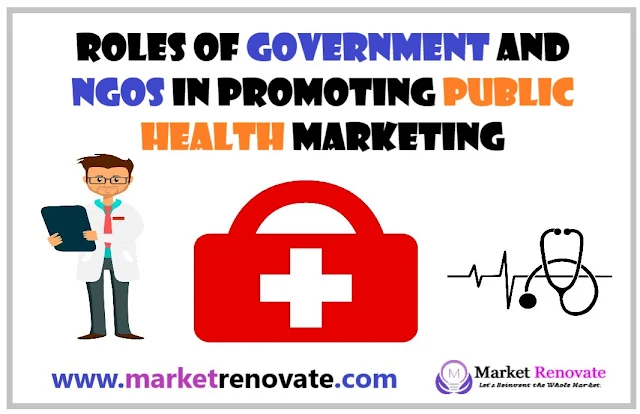Roles of Government and NGOs in Promoting Public Health Marketing
Public health marketing plays a major role in raising awareness, encouraging healthy behaviors, and fostering community engagement for improved well-being. Governments and non-governmental organizations (NGOs) are key players in driving these efforts. By collaborating and complementing each other’s strengths, they can create a comprehensive and impactful approach to promoting public health through effective marketing strategies.
Roles of Government in Public Health Marketing:
Governments hold a central role in shaping public health policies, regulations, and initiatives. They have the authority to implement strategies that have a broad societal impact. Here’s how governments contribute to public health marketing:
- Policy Development: Governments formulate policies that guide public health marketing campaigns. These policies are designed to address pressing health concerns, promote preventive measures, and regulate industries to ensure public safety.
- Resource Allocation: Governments allocate funds for public health campaigns and programs. These resources empower marketing efforts to reach a wider audience through various channels, including media, community events, and educational materials.
- Regulation and Compliance: Governments enact regulations that protect public health and safety. They oversee labeling and advertising standards for products, ensuring that marketing claims are accurate and not misleading.
- Health Promotion Initiatives: Governments initiate and support health promotion campaigns that focus on issues such as tobacco cessation, nutrition, physical activity, and vaccinations. These campaigns leverage marketing techniques to convey important health messages.
- Community Engagement: Governments work closely with communities to understand their health needs and preferences. This collaboration ensures that marketing campaigns are culturally sensitive and resonate with the target audience.
- Monitoring and Evaluation: Governments monitor the impact of public health marketing initiatives. Data collected helps assess the effectiveness of campaigns and informs future strategies.
Roles of NGOs in Public Health Marketing:
Non-governmental organizations (NGOs) are instrumental in implementing localized and community-oriented public health marketing efforts. Here’s how NGOs contribute to promoting public health:
- Community Empowerment: NGOs work at the grassroots level, engaging communities in health-related activities. They tailor marketing messages to address specific community needs and concerns.
- Innovative Campaigns: NGOs often pioneer innovative marketing campaigns that capture people’s attention and drive behavior change. Creative approaches, such as social media challenges or interactive workshops, can be effective tools.
- Advocacy and Awareness: NGOs advocate for specific health issues, raising awareness and mobilizing support from the public, policymakers, and other stakeholders. Their advocacy efforts amplify the impact of public health marketing.
- Education and Skill Building: NGOs provide education on health-related topics and empower individuals with the knowledge and skills needed to make informed decisions about their well-being.
- Targeted Outreach: NGOs identify vulnerable populations or underserved communities and tailor marketing efforts to reach them effectively. This ensures that no one is left behind in health promotion endeavors.
- Partnerships and Collaborations: NGOs often collaborate with governments, international organizations, and private entities to expand the reach and resources of public health marketing campaigns.
The Synergy between Government and NGOs:
The collaboration between governments and NGOs in public health marketing creates a powerful synergy. Their combined efforts can yield more comprehensive, impactful, and sustainable outcomes. Here’s how their collaboration works:
- Shared Goals: Both governments and NGOs share the goal of improving public health outcomes. Their collaboration ensures that efforts are aligned and resources are utilized efficiently.
- Leveraging Expertise: Governments bring regulatory authority and resources, while NGOs bring grassroots expertise and innovative approaches. This combination enhances the effectiveness of public health marketing.
- Reaching Diverse Audiences: Governments often have access to broader communication channels, while NGOs have a deep understanding of local communities. Together, they can ensure that messages reach diverse audiences effectively.
- Flexibility and Responsiveness: NGOs’ agility allows them to quickly respond to emerging health concerns. Governments can support these efforts through funding, policy alignment, and regulatory guidance.
- Data-Driven Decision Making: Governments and NGOs can collaboratively gather and analyze data to assess the impact of marketing campaigns. This data informs strategic adjustments for better outcomes.
Real-World Examples:
In the fight against tobacco use, governments enact laws to regulate tobacco advertising, while NGOs run aggressive anti-smoking campaigns targeting specific demographics. This combination has led to reduced smoking rates in many regions.
During disease outbreaks, governments provide accurate information and guidelines, while NGOs engage in grassroots campaigns to promote preventive behaviors like handwashing and social distancing. This synchronized effort minimizes the spread of diseases.
Conclusion
The roles of governments and NGOs in public health marketing are intertwined and essential for improving the health and well-being of societies. Governments provide the regulatory framework, resources, and broad policy direction, while NGOs bring creativity, community engagement, and targeted approaches to the table.
By working in harmony, these entities create a unified and powerful force that drives positive health behaviors, fosters awareness, and ultimately enhances the overall health and quality of life for individuals and communities.






Please leave your comments or ask your queries here. The comments shall be published only after the Admin approval.